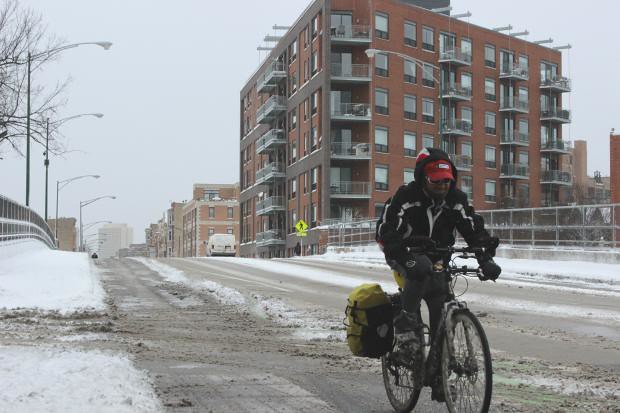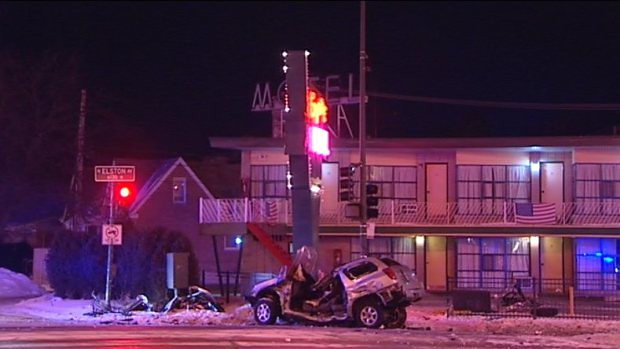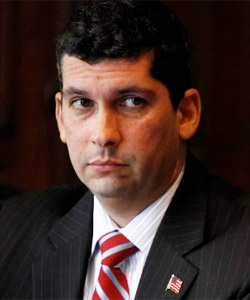Proponents and opponents discussed the proposed Milwaukee safety overhaul Wednesday night at a Jefferson Park Neighborhood Association meeting in the basement of the Congregational Church. Although association president Judy Skotzko emphasized the meeting was not called specifically to talk about the road diet and protected bike lane project, many of the nearly 40 neighbors and advocates present seemed eager to debate its merits.
Milwaukee Avenue currently has four travel lanes and a turning lane, plus conventional bike lanes or sharrows, between the Jefferson Park Transportation Center and Elston. Since motor vehicle counts for this stretch are consistently less than 20,000 per day, the wide layout provides too much capacity for the number of cars, which encourages speeding. In the past five years there have been 970 crashes on this two-mile segment, including 17 serious injuries and three fatalities – the last two deaths occurred Monday night after a rollover crash on the 6000 block of North Milwaukee.
The Chicago Department of Transportation has proposed the road diet on this stretch, which would convert the street to two travel lanes and a turn lane, plus protected bike lanes. This reconfiguration would help calm traffic and shorten pedestrian crossing distances. Some parking spaces would be removed at intersections to make it easier for right-turning motorists to see cyclists in the lanes.
45th Ward Alderman John Arena has expressed support for the idea but, despite CDOT traffic and parking counts that show the makeover would not negatively impact traffic flow or parking availability, there has been stiff opposition from some neighbors. At a rowdy public meeting on the plan on January 13, residents jeered and booed CDOT engineers as they discussed the proposal.
John Garrido, a police lieutenant and lawyer who lost to Arena in the 2011 election and is currently suing him, started a petition against the road diet and protected lanes, which has gotten about 580 signatures in eight days. In response, Bob Kastigar, a longtime safe streets advocate and former Jeff Park resident, launched a petition endorsing the plan, which has garnered 420 signatures in only three days.
The JPNA meeting was decidedly less confrontational than the earlier forum. After other association business was addressed, 45th Ward reps Andi VanderKolk and Owen Brugh helped introduce and facilitate the discussion about the Milwaukee improvements. One attendee suggested participants stand while speaking and be given the floor until they sat down, which helped keep the dialogue respectful.
VanderKolk emphasized that the city has not developed a formal plan for Milwaukee but is still gathering information on the project, noting that maintaining the current configuration or striping buffered lanes are also possibilities. She promised Arena’s office would relay all comments to CDOT staff. She also stressed that the rehab is not just a bike project and but also could include street resurfacing, signal retiming, pedestrian refuge islands, and new street furniture, as well as a review of bus operations to reduce conflicts between buses and bikes.
A man describing himself as a transportation engineer and cyclist said he’s against the installation of protected lanes, citing concerns about the removal of snow and debris. CDOT says its goal is to plow PBLs within 24 hours of snowfall. The man added that’s he’s worried about the possibility of more right hook crashes due to sightline issues. The New York City Department of Transportation found that streets where protected bike lanes were installed saw a 12-to-52-percent decrease in injury-causing crashes for all road users.
Garrido said he supports all the proposed improvements to Milwaukee, except for the road diet and PBLs, i.e. the main features that would actually help reduce crashes. “We want something done, we just have concerns about one lane in each direction,” he said. Another attendee echoed his sentiment, asking, “Just how many people are actually using a bike?”
VanderKolk noted that Divvy bike-share has dramatically increased bicycling in the city. The system is slated to expand to new neighborhoods this year. Pace ridership is also on the rise, and the suburban bus system runs buses northwest from the transportation center on Milwaukee. She said CDOT’s goal is to create a safer, more efficient roadway for bike riders and transit users, as well as pedestrians and drivers.
Attendees also suggested longer walk signal times and pedestrian scramble phases at some intersections could improve access for people on foot. “You shouldn’t have to have to play Frogger when crossing the road,” one said. Another argued that dangerous conditions on Milwaukee are harming the economic potential of the area. While parking wasn’t one of the dominant topics, a participant expressed the need to retain car spaces for future development on lots and in storefronts along Milwaukee that currently sit vacant.
Jeff Marcus, who said he rides a bike regularly, said there’s a need for more traffic enforcement, education, and common courtesy among all users. Marcus implored those present to accept cycling as a legitimate means of transportation, mentioning two recent bike fatalities. His three-minute speech received applause, suggesting that both opponents and proponents of the road diet share a common goal of improving safety. However, scenarios that largely maintain the status quo on Milwaukee won’t achieve that aim.
There will be another public meeting to discuss the street redesign this spring, at a time and location TBA. In the meantime, you can email your comments about the project to Vanderkolk at andi.vanderkolk[at]cityofchicago.org. If you haven’t already done so, be sure to also voice your support for the safety overhaul by signing Kastigar’s petition.






